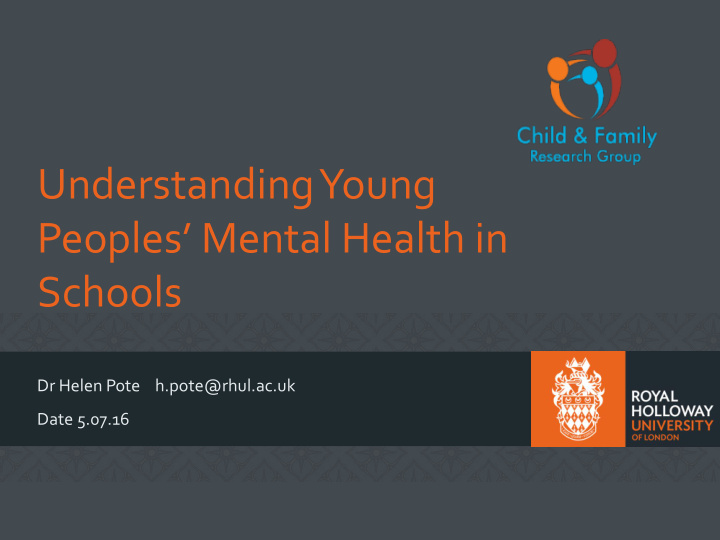



Understanding Young Peoples’ Mental Health in Schools Dr Helen Pote h.pote@rhul.ac.uk Date 5.07.16
Why is the mental health of young people important? Mental health problems are Adolescence is a time we can common intervene and make a difference • 850,000 children aged 5-16 to young people • have mental health problems Universal approaches • (1 in 10 children) Targeted support • Three children in every classroom have a diagnosable mental health disorder. £34bn + £1.2b Mental health problems link to a Child mental Health Problems range of other difficulties lead to Adult mental health • Poor school attainment problems • Exclusions Of those with mental health • Teenage pregnancy problems in adult life • Prison sentence 50% start by the age 14 • Drug dependency 75% start by the age of 24 2
Relevant Policy Counselling in Mental health and schools: a blueprint behaviour in schools for the future Departmental advice for school staff Departmental advice for school leaders and counsellors March 2016 February 2016 3
Current Policy Key Points Intervention • Universal and Targeted Interventions in schools Prevention & Early treatment • CYP IAPT & evaluate counselling services in schools Evidence based • CAMHS Single points of access - One-Stop-Shops Timely access and waiting times Reduce Stigma • Peer support networks for young people and parents. Integration • Named contact in CAMHS and schools for mental health Service without me - • Youth Advisors on Planning Boards No decision about me • Joint training + improvements in Teacher training. Develop the workforce • Mental Health screening and Goals Based evaluations Outcomes that matter young people 4
Overview: Risk and Resilience Individual School Interventions Contextual & Evaluation Cognitive Biases Family Functioning Peer mentoring Self-presentation Brain development programmes Peer relations & bullying Emotional regulation Mental Health First Aid for Teachers Emotion Processing 5
Slavny & Pote Cognitive Biases -Vulnerable thinking Patterns in Adolescence The peak age of onset for many mental health problems is adolescence, a time of remarkable physical and behavioural changes. Cognitive biases are strongly associated with anxiety and depression and are treated in effective mental health interventions (e.g. CBT) Examples: • Overgeneralising negative experiences • Threat interpretation : Interpreting ambiguous stimuli as threatening • Negative Attributions : attributing the cause of negative events to internal factors Little research on how these thought patterns develop in normal adolescents and how this contributes to their vulnerability to mental health difficulties. 6
Two studies on vulnerable thinking patterns Cross Sectional design Longitudinal design Comparing two groups – Two time points over 12m Early and Late Adolescence N = 139, N=512 Mean Age at Time1 = 12.58 y Early N = 258, 10 - 13 years 69 boys, 80 girls Late N= 282, 14 - 17 years 283 girls; 213 boys 21% White British; 26.8%Bangladeshi 23.7% British Asian 7
Measures Questionnaire (Goodman,1997) Strength and Difficulties Children’s Negative Cognitive Errors Questionnaire – Revised (Maric et al. 2011) Children’s Attributional Style Questionnaire - Revised (Kaslow & Nolen-Hoeksema, 1991) Ambiguous Situations Questionnaire-Child (Barrett et al., 1996) 8
Results Negative Attributions Selective Abstraction p = .001 &.008 p < .001 Overgeneralasing p < .001 & .001 Mind Reading Threat p=.009 Interpretation p = .004 & 007 9
No-one likes me in this class, I can see it in their faces. It is the same at the youth centre. I must be so boring there is nothing about me to like. 10
When do thinking patterns change? 3 Overgenerali sing 2.8 Selective abstraction Mean bias score Mind reading 2.6 p s > .05 Personalising 2.4 UAC 2.2 2 Time 1 Time 2 Late 11 – 13 adolescents 12 – 14 14 – 17 n = 282
Conclusions 1. Common biased thinking patterns associated with mental health problems are increasing naturally in this age group. 2. Critical period of change is around 12-14years. 3. These cognitive biases should be the focus for early intervention to help develop more functional thinking styles. 12
Talking to young people about mental health • Young people often want to talk to a teacher about their problems as the first step to getting help • It is important these 1st conversations go well. • Courage • We know that early detection and early intervention for mental health difficulties leads to better outcomes • Teachers can feel out of their depth and not sure of the best resources 13
What helps you talk to teachers? Young Person’s View
MindAid - Mental Health First Aid for Teachers Supporting teachers with early recognition, screening and support for young people showing signs of mental health problems is key to effective early intervention in schools. Training in mental health is effective but costly. Ongoing support and refreshing knowledge is problematic. Using evidence from Surrey TaMHS schools evaluation with 2500 teachers. CYP IAPT – MindAid app Links to SDQ and MindEd resources Research planned to support its role out. 15
16
Key Features of MindAid LISTEN. Specific suggestions on the best way to talk about mental health problems with young people: SCREEN: Use questionnaires to assess problems and prioritize young people in need. LEARN more about mental health. Content is linked to existing information resources such as MindED REFER: easily accessible self help and referral information to make signposting to effective help easier. REMIND. Remember to follow up kids who have problems. .
h.pote@rhul.ac.uk 18
Recommend
More recommend